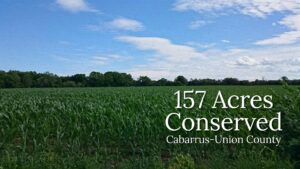
By Ruth Ann Grissom
November 11, 2015
The song sparrow was tangled in a mist net stretched between a stand of big bluestem and
a blackberry thicket. It flapped and flailed, but settled a bit as Alicia’s nimble fingers worked to
extract it – first the tiny claws and legs, then the wings and finally the head. An experienced
bander, she made it look deceptively easy. She cradled the sparrow in her palm then tucked it in
a cotton bag. We walked the fresh-mown path to the station where the bird would be assessed
and banded.
We captured dozens of song sparrows and other species that warm and sunny day in mid-
October. It was an auspicious start to an on-going effort to collect data about birds in the early
successional habitat we’ve created in the Uwharries. We hope to learn more about the
populations using the areas we’ve converted from fescue to native warm season grass. Do we
have all the expected species? Are we hosting any unusual species? Are certain species
benefiting more than others? Is the habitat producing and sustaining healthy birds? Answering
these questions about the sparrows and other birds in our grasslands might help us – and others –
make better management decisions.
Back in the day, ornithologists would have “collected” the birds and taken the carcasses
back to the lab for study. Fortunately, scientists now employ non-lethal means. They capture
birds in mist nets, quickly assess them in the field, then release them with a band attached to their
leg. Banders adhere to strict protocols – governing factors such as weather conditions and length
of time a bird remains in the net – to minimize stress on their captives. Banding is a science and
an art. It takes practice and patience, and it requires a permit from U.S. Fish and Wildlife
Service, one of the agencies spearheading this study.
We also have high school and college students volunteering their time for the chance to train with experienced banders.
At the banding station, the first order of business is to determine the species, which can
sometimes be challenging in fall, even with a bird in hand. This time of year, many adults have
lost their distinctive breeding plumage and juveniles haven’t come into theirs yet. Sparrows are
notoriously difficult, colored up with subtle variations of brown, rust, gray and buff. While we
have only five species in the Piedmont during breeding season, another a half-dozen species
arrive to spend the winter and a few others potentially pass through during migration.
Alicia measured the length of the wing then got a weight by sticking the bird head-first
into a medicine bottle and putting it on a sensitive scale. I logged her results on a data sheet as
she continued her assessment. She blew on the sparrow’s chest, separating the feathers so she
could gauge its body fat. This can tell you a lot about the quality of habitat and the stress of
migration. She also blew the feathers on the back of its head to get a view of its skull. It won’t
be fully fused if the bird hatched during the current year’s breeding season. The condition of the
wing and tail feathers also provides clues about the bird’s age. Unless the plumage was obvious,
we didn’t attempt to sex the birds. Typically, the brood patch and cloacal protuberance are
assessed only during breeding season.
Finally, Alicia attached a metal band to the song sparrow’s delicate leg, crimping gently
with a pair of special pliers. The unique number will allow the bird to be identified if it is
recaptured here or elsewhere. This can provide information about how long a bird lives and
where it goes on migration
It was an exhilarating and exhausting day. We were smitten with a spiffy white-crowned
sparrow, a winter resident in the Piedmont, and always thrilled to have a common-yellow throat
or palm warbler in the mix. During the afternoon lull when the nets were empty, we turned our
attention skyward and saw several species of raptors, including a bald eagle and migrating
peregrine falcon. I brought out my welding gloves in case a Cooper’s hawk went after a stranded
songbird or the northern harrier inadvertently collided with a net as she skimmed the big
bluestem. Unfortunately, a black-billed cuckoo, which isn’t seen often in the Piedmont, also
eluded the nets.
I took my first steps as a bird bander, recording data and extracting grasshoppers from the
nets, but I doubt I’ll ever work up the confidence to handle a warbler or sparrow. My passion is
providing the habitat. The day we were testing the equipment, we captured a Tennessee warbler,
one of the “confusing fall warblers” that can be difficult to identify in the field. It breeds in the
forests of New England and Canada, but prefers brushy habitat during migration to the tropics.
Knowing that bird was taking advantage of our recently-established grasslands in the Uwharries
makes me think we’re doing something right. For helping us to understand and manage our
habitat, a bird in the hand might indeed be better than two in the bush.